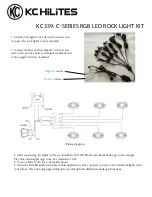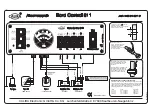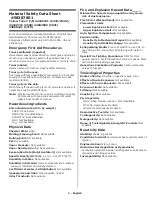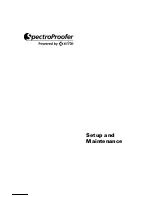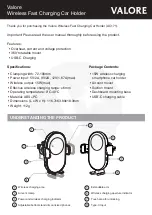
9
PR
O
BL
EM
SO
LU
T
IO
N
S
D
iff
icu
lty
in
p
um
pi
ng
u
p
th
e
aw
ni
ng
1.
T
he
in
fla
tio
n
va
lv
e
is
n
ot
fu
lly
s
cre
w
ed
in
to
t
he
A
irPo
le
.
2.
T
he
in
fla
tio
n
tu
be
is
t
w
is
te
d
at
t
he
v
al
ve
.
T
hi
s
m
ay
a
ls
o
be
in
di
ca
te
d
by
a
no
is
e.
D
O
N
O
T
co
nt
in
ue
t
o
in
fla
te
u
nt
il
th
e
tu
be
h
as
b
ee
n
un
tw
is
te
d
(s
e
e
pa
ge
4
).
If
yo
u
su
sp
ect
a
n
ai
r
le
ak
1.
C
he
ck
th
at
th
e
in
fla
tio
n/
de
fla
tio
n
va
lv
e
is
p
ro
pe
rly
scre
w
ed
in
a
nd
t
ha
t
th
e
bl
ack
‘O
’ r
in
g
se
al
is
in
p
la
ce
.
2.
C
he
ck
th
at
th
e
to
p
ca
p
on
t
he
in
fla
tio
n
va
lv
e
is
d
on
e
up
ti
gh
tly.
If
yo
u
th
in
k
yo
ur
aw
ni
ng
h
as
a
w
at
er
le
ak
1.
Mo
st
s
u
sp
ect
ed
le
aka
ge
is
a
ct
ua
lly
co
nd
en
sa
tio
n
(s
ee
co
nd
en
sa
tio
n
se
ct
io
n
of
th
is
m
an
ua
l).
T
hi
s
fo
rm
s
on
t
he
in
si
de
o
f
th
e
aw
ni
ng
f
ab
ric.
T
ry
to
in
cre
as
e
th
e
ve
nt
ila
tio
n
by
o
pe
ni
ng
t
he
d
oo
rs
a
nd
v
en
til
at
io
n
po
rt
s.
D
o
no
t co
ok
in
yo
ur
aw
ni
ng
.
T
he
f
ab
ric
,
us
ed
t
o
m
ake
t
hi
s
aw
ni
ng
,
ha
s
a
m
as
si
ve
6
00
0
mm
hyd
ro
st
at
ic
h
ea
d,
s
o
it
is
e
xt
re
m
el
y
un
like
ly
th
at
it
w
ou
ld
le
ak
.
If
yo
ur
a
w
ni
ng
h
as
a
w
at
er
le
ak
at
s
pe
ci
fic
po
in
ts
/a
re
as
1.
T
he
m
ai
n
se
am
s
of
th
is
a
w
ni
ng
h
av
e
be
en
f
ac
to
ry
ta
pe
d
to
h
el
p
pre
ve
nt
le
aka
ge
.
D
ep
en
di
ng
u
po
n
yo
ur
ex
pe
ct
at
io
ns
, i
t m
ay
be
ne
ce
ss
ary
to
t
re
at
th
e
re
m
ai
ni
ng
s
ea
m
s
w
ith
a
s
ea
m
s
ea
la
nt
.
Se
am
se
al
an
t
sh
ou
ld
a
ls
o
be
a
pp
lie
d
to
a
re
as
w
h
ere
t
he
t
ap
in
g
is
d
am
ag
ed
or
ha
s
pe
el
ed
a
w
ay
th
ro
ug
h
w
ea
r
an
d
te
ar.
It
ca
n
al
so
b
e
ap
pl
ie
d
to
are
as
w
he
re
a
le
ak
m
ay
ha
ve
d
ev
el
op
ed
.
Se
am
se
al
an
t
is
a
va
ila
bl
e
th
ro
ug
h
yo
ur
de
al
er.
T
R
O
U
BL
ES
H
O
O
T
IN
G
10
IN THE EVENT OF A PUNCTURE
If you suspect a puncture follow the following:
1. Undo the inflation/deflation valve from the pole and re-attach ensuring that
the tube does not twist and that the valve is firmly connected.
2. Re-inflate the AirPole.
3. If tightening the hose fittings does not solve the problem then the AirPole
may be punctured.
TO REMOVE AN AIRPOLE
3. Unzip the sleeve holding the AirPole.
4. You should now be able to remove the AirPole.
5. Unzip the protective cover of the AirPole, whilst deflated, to expose the
inflatable tube.
6. Locate the puncture. This is made easier if you blow some air into the tube.
For small holes it may be necessary to submerge the inflatable tube in
water.
7. Once located the tube can be repaired using repair tape. We recommend
Kampa Tent & Awning Repair Tape—available from your dealer.
The repair can be enhanced by using a combination of the tape with Kampa
Repair Solution.
Follow the manufacturers instructions to repair.
Another alternative is to replace the tube. Spares are available from your dealer
or direct from Kampa.
Once a repair or replacement has been made, the AirPole can simply be zipped
back into the sleeve.







